RC10. Building an Adder
Daily dispatches from my 12 weeks at the Recurse Center in Summer 2023
A while back I built a 4-bit adder on a breadboard and managed to reduce each full adder component to five logic gates. In truth I’m not sure how I managed it, since I didn’t know about boolean algebra. From what I can deduce from the long series of deranged-looking and often-abandoned schematics I discovered in my notebook, it took quite a bit of trial and error.
Well, I’m building another adder (and eventually an ALU), and this time I’m determined to derive the logic using boolean algebra. Thanks to some collaboration from a fellow recurser, I’ve figured it out.
A Quick ‘n Dirty Primer on Binary
First things first: The number system we normally use is base 10, or decimal, or denary. That means we have 10 digital to choose from: your friends and mine, 0, 1, 2, 3, 4, 5, 6, 7, 8, and 9. But we can count to higher than 9, can’t we? When we run out of digits, we carry over the 1 from the ones place to the tens place and keep going.
Same idea with binary, except that it’s base-2, which means we have two digits to choose from, 0 and 1. And that means that we have to carry over once we exhause those two digits. So counting from 0 to 10 looks more like this:
0 => 0
1 => 1
10 => 2
11 => 3
100 => 4
101 => 5
110 => 6
111 => 7
1000 => 8
1001 => 9
1010 => 10
In a base-10 number system, each place value represents \(10^n\), where \(n\) is the place from right to left. Hence the ones place, the tens place, the hundreds place, etc. In base-2, each place value represents instead \(2^n\).
Binary Addition
When it comes to addition, well, binary addition once again follows the same logic and rules used in denary addition, except with fewer available digits.
0 + 0 = 0
1 + 0 = 1
0 + 1 = 1
1 + 1 = 10 => carry the one
Here’s a slightly more complicated example. Let’s say we’re adding 21 and 19 in decimal. We start with the digits on the right – the least significant ones since they’re the ones place – and we add them up. If they exceed 9, what do we do? Carry the one! And repeat.
\[\begin{array}{r@{\hskip 0em}r@{\hskip 0em}r} & ^1 & \\ & 2 & 1 \\ + & 1 & 9 \\ \hline & 4 & 0 \\ \end{array}\]In binary it’s pretty much the drill, except for the fewer available digits thing. So if we want to add 21 (10101 in binary) and 19 (10011), it would look a little like this:
\[\begin{array}{r} & & ^1 & & ^1 & ^1 & ^1 \\ & & & 1 & 0 & 1 & 0 & 1 \\ + & & & 1 & 0 & 0 & 1 & 1 \\ \hline & & 1 & 0 & 1 & 0 & 0 & 0 \end{array}\]Towards an Adder
This is all well and good, but the question is how to combine logic gates to produces this behavior. What we need is to combine two input bits, a and b, and somehow spit out both a sum bit y and a carry bit c.
The Sum Bit
If we’re adding two bits, there are only four possible combinations of digits we can add together – 0 + 0, 0 + 1, 1 + 0, and 1 + 1. A truth table makes clear what we would expect from each of these combinations:
| a | b | sum y |
|---|---|---|
| 0 | 0 | 0 |
| 0 | 1 | 1 |
| 1 | 0 | 1 |
| 1 | 1 | 0 |
It seems, then, that the sum bit is the logical combination of a XOR b. Or to put it formally:
\(y_{i} = a_{i} \oplus b_{i}\)
where i is the bit place.
The Carry Bit
The truth table for the carry bit, alternatively, would look like this:
| a | b | carry bit c |
|---|---|---|
| 0 | 0 | 0 |
| 0 | 1 | 0 |
| 1 | 0 | 0 |
| 1 | 1 | 1 |
In this case, the carry bit is the logical combination of a AND b. Formally: \(c_{i+1} = a_{i} \cap b_{i}\) where i is the bit place. (Note that the carry bit is at place i + 1 since it will be summed along with the next most significant digits.)
The Full Adder
This is all well and good, but as we saw in the sample binary addition equation above, we’re acutally always dealing with three terms: not only input a and input b, but also carry bit c from the next least significant digit.
The logic table for a full adder, then – one which takes inputs a and b and a carry bit c – would look like this:
| ai | bi | ci | sum yi | carry ci+1 |
|---|---|---|---|---|
| 0 | 0 | 0 | 0 | 0 |
| 0 | 0 | 1 | 1 | 0 |
| 0 | 1 | 0 | 1 | 0 |
| 0 | 1 | 1 | 0 | 1 |
| 1 | 0 | 0 | 1 | 0 |
| 1 | 0 | 1 | 0 | 1 |
| 1 | 1 | 0 | 0 | 1 |
| 1 | 1 | 1 | 1 | 1 |
Constructing a Boolean Expression for the Sum Bit
The first step in figuring out how to build an adder is to sort out the logic for the sum bit. I’ll follow the approach of constructing a logical statement for each True, or 1, output, ORing the results together, and simplifying.
| ai | bi | ci | sum yi | Logic |
|---|---|---|---|---|
| 0 | 0 | 0 | 0 | |
| 0 | 0 | 1 | 1 | NOT(A) AND NOT(B) AND C |
| 0 | 1 | 0 | 1 | NOT(A) AND B AND NOT(C) |
| 0 | 1 | 1 | 0 | |
| 1 | 0 | 0 | 1 | A AND NOT(B) AND NOT(C) |
| 1 | 0 | 1 | 0 | |
| 1 | 1 | 0 | 0 | |
| 1 | 1 | 1 | 1 | A AND B AND C |
ORing it all together, the full expression is as follows:
At this point, we might recognize that the first half of the equation has an XOR expression lurking within: \((\lnot c \land b) \lor (c \land \lnot b) = c \oplus b\). And the second half of the equation has a negated XOR, or XNOR, expression in it: \((\lnot c \land \lnot b) \lor (c \land b) = c \odot b = \lnot (c \oplus b)\)
Substituing the somewhat simpler notation in, our equation looks like this:
\[\begin{array}{l} & (\lnot a \land (c \oplus b)) \lor (a \land \lnot (c \oplus b)) \\ \end{array}\]If we temporarily replace the \((c \oplus b)\) XOR statements with a new variable, our expression suddenly becomes:
which, we should recognize, is another XOR expression:
Expanding our x variable, the final logical expression looks like this:
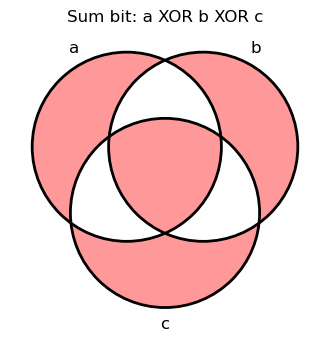
Constructing a Boolean Expression for the Carry Bit
Now that we’ve sorted out the sum bit, the next step is designing the logic for the carry bit. Once agan, I’ll take the approach of constructing a logical statement for each True, or 1, output from the truth table, ORing the results together, and simplifying.
The logic table for a full adder, then – one which takes inputs a and b and a carry bit c – would look like this:
| ai | bi | Ci | ci+1 | Logic |
|---|---|---|---|---|
| 0 | 0 | 0 | 0 | |
| 0 | 0 | 1 | 0 | |
| 0 | 1 | 0 | 0 | |
| 0 | 1 | 1 | 1 | NOT(A) AND B AND C |
| 1 | 0 | 0 | 0 | |
| 1 | 0 | 1 | 1 | A AND NOT(B) AND C |
| 1 | 1 | 0 | 1 | A AND B AND NOT(C) |
| 1 | 1 | 1 | 1 | A AND B AND C |
Thus our starting equation is:
\[\begin{array}{llr} & (\lnot a \land b \land c) \lor (a \land \lnot b \land c) \lor (a \land b \land \lnot c) \lor (a \land b \land c) \\ = & (c \land ((\lnot a \land b) \lor (a \land \lnot b) \lor (a \land b)) \lor (a \land b \land \lnot c ) &\Leftarrow \text{by distributive law}\\ \end{array}\]This is complicated-looking, but as with the sum bit logic, there’s a major simplification that can happen once we recognize that the term \((\lnot a \land b) \lor (a \land \lnot b) \lor (a \land b) = a \lor b\). This becomes clear just from thinking about the three terms making up the equation, but it can also be derived like so:
\[\begin{array}{llr} & (\lnot a \land b) \lor (a \land \lnot b) \lor (a \land b) \\ = & (\lnot a \land b) \lor (a \land ( \lnot b \lor b)) &\Leftarrow \text{by distributive law}\\ = & (\lnot a \land b) \lor (a \land 1) &\Leftarrow \text{by compliment law}\\ = & (\lnot a \land b) \lor a &\Leftarrow \text{by identity law}\\ = & \lnot \lnot ((\lnot a \land b) \lor a) &\Leftarrow \text{by double negation law}\\ = & \lnot ( \lnot (\lnot a \land b) \land (\lnot a)) &\Leftarrow \text{by de Morgan's theorem}\\ = & \lnot (( \lnot \lnot a \lor \lnot b) \land (\lnot a)) &\Leftarrow \text{by de Morgan's theorem}\\ = & \lnot (( a \lor \lnot b) \land (\lnot a)) &\Leftarrow \text{by double negation law}\\ = & \lnot (( a \land \lnot a) \lor (\lnot b \land \lnot a)) &\Leftarrow \text{by distributive law}\\ = & \lnot (0 \lor (\lnot b \land \lnot a)) &\Leftarrow \text{by compliment law}\\ = & \lnot (\lnot b \land \lnot a) &\Leftarrow \text{by identity law}\\ = & \lnot \lnot b \lor \lnot \lnot a &\Leftarrow \text{by de Morgan's theorem} \\ = & b \lor a &\Leftarrow \text{by double negation law}\\ \end{array}\]Picking up from where we left off, then:
\[\begin{array}{llr} & (c \land ((\lnot a \land b) \lor (a \land \lnot b) \lor (a \land b)) \lor (a \land b \land \lnot c )\\ = & (c \land (a \lor b)) \lor (a \land b \land \lnot c ) &\Leftarrow \text{by derivation above}\\ = & (c \land a ) \lor (c \land b) \lor (a \land b \land \lnot c ) &\Leftarrow \text{by distributive law}\\ = & a \land (c \lor (b \land \lnot c) \lor (b \land c ) &\Leftarrow \text{by distributive law}\\ = & a \land (c \lor b) \lor (b \land c ) &\Leftarrow \text{by redundancy law}\\ \end{array}\]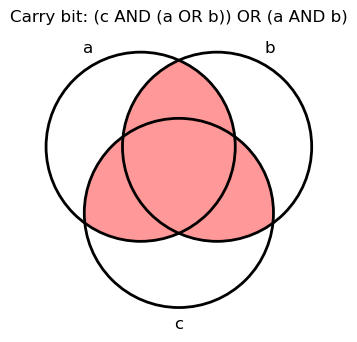
The Final Full Adder Circuit
Put it all together and it looks something like this:
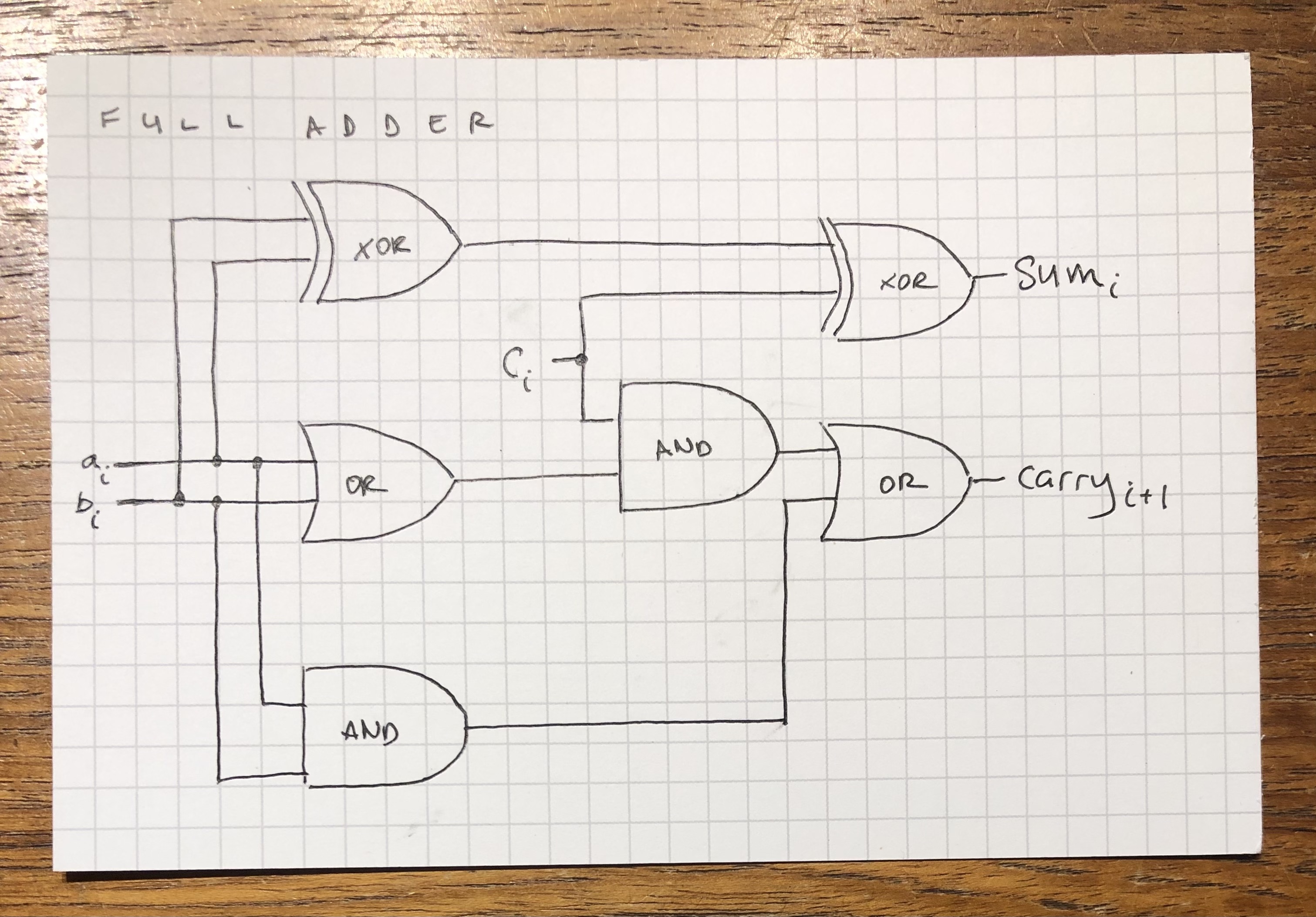
Or, if you’re slightly masochistic and would prefer exclusively NAND gates, like this:
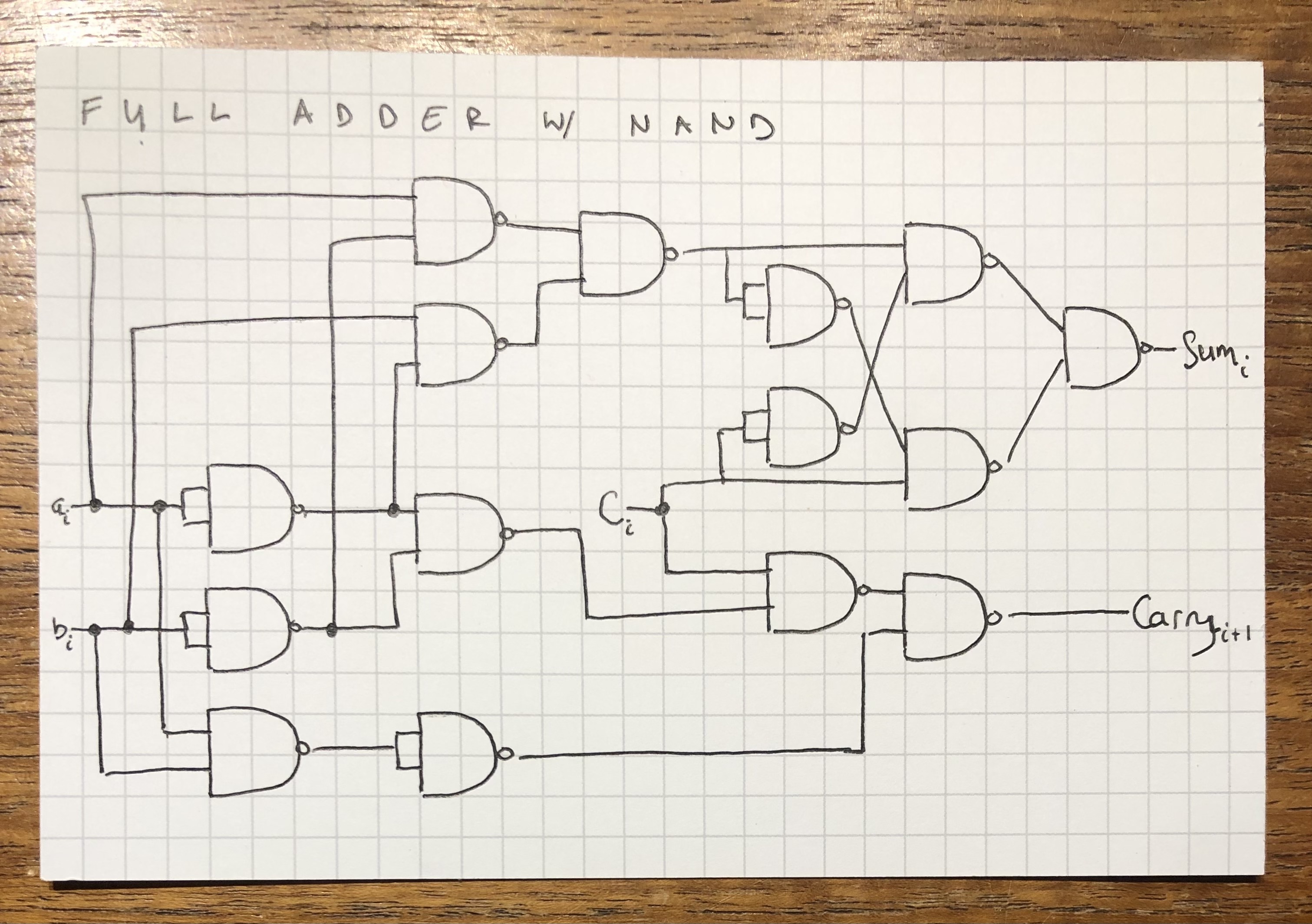
Update 2023-06-03 Made a mistake above. Actually should look like this:
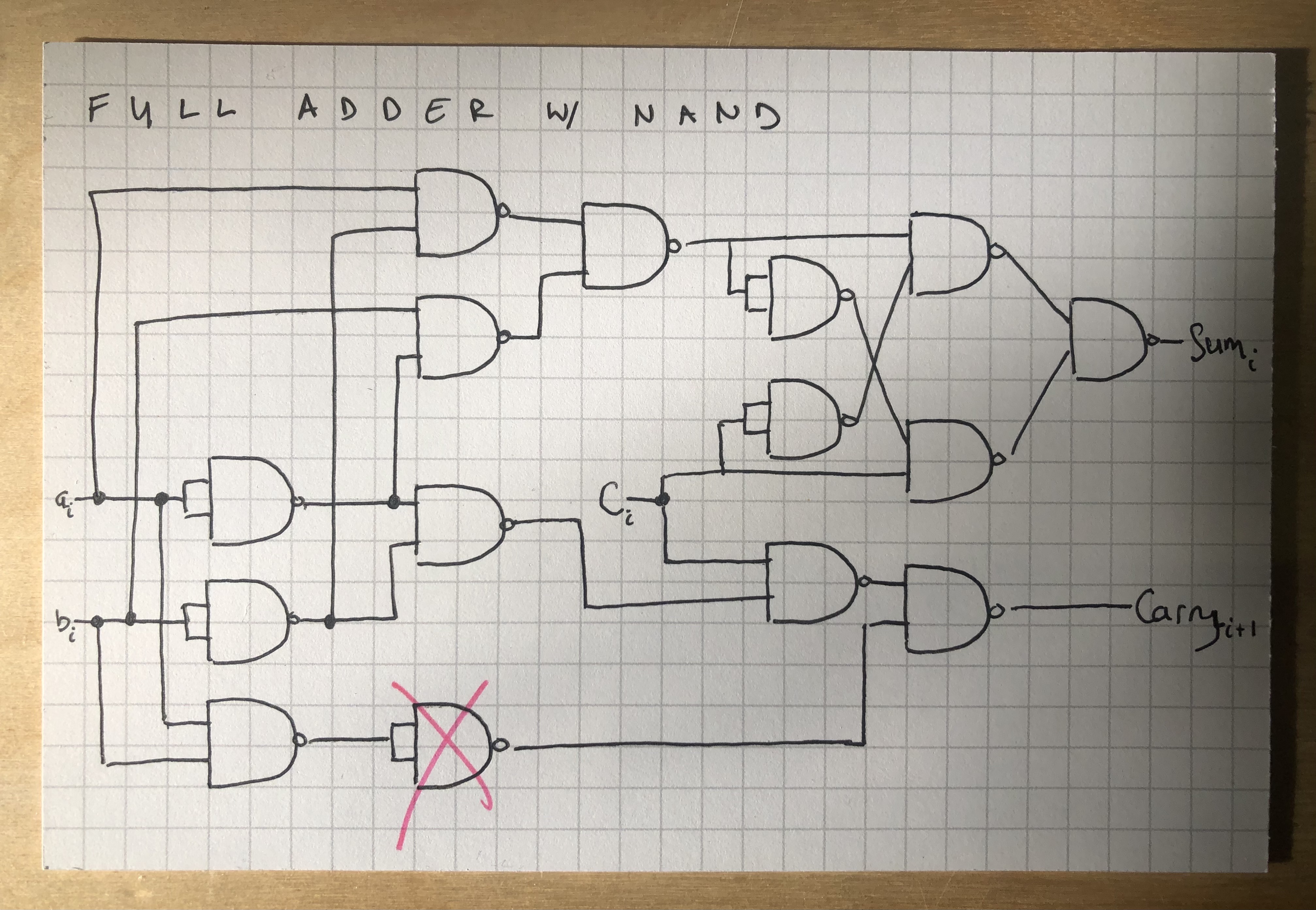
Etc.
Besides working on simplifying these boolean equations, the only other thing I did RC-wise on this Memorial Day was meet with my BYOL groupmates (actually groupmate today because of the holiday) and talked C and parsers. We made great progress contending with a few bugs that turned out to just be quirks of C. Ya live ya learn!
